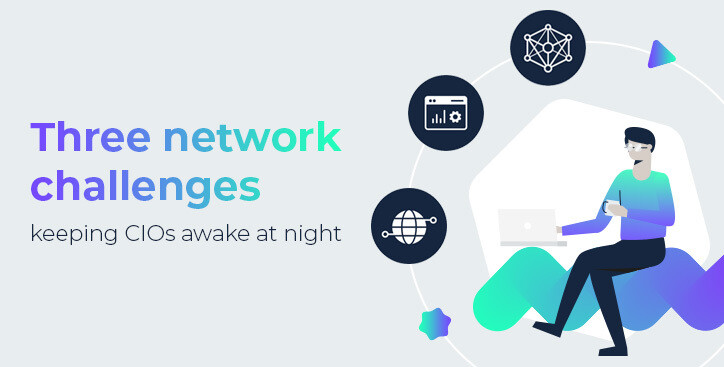Three network challenges keeping CIOs awake at night
By Alex Hawkes|20 September, 2021

2. Network management
 The growing complexity and size of enterprise networks means it is harder than ever to monitor and maintain them.
The growing complexity and size of enterprise networks means it is harder than ever to monitor and maintain them.
The promise of the public cloud is a great case in point. It was initially expected that most enterprises would opt for a cloud-only approach but as the technology has matured, hybrid and multi-cloud approaches have become commonplace.
Not all applications are suitable for the public cloud, meaning on-premise data centres are still active, and each public cloud has its own strengths and weaknesses, forcing businesses to mix-and-match to suit their needs.
Yesterday’s challenge was vendor lock-in - but today’s networks mean multi-vendor infrastructures and multi-cloud architectures are commonplace. This opens up great opportunities for the business but also creates environments that can be challenging for network engineers who are faced with proprietary systems, different interfaces and specialist requirements.
Bringing in the best-of-breed solutions from today’s vendors means figuring out how to integrate and support multiple solutions.
No two networks are the same, which makes it hard to predict the consequences of making any changes beyond the routine. Relying on a myriad selection of third-party SaaS, PaaS, and IaaS providers could, for example, introduce multiple points of failure.
Real-time visibility and control over your network connections can help alleviate some of these challenges and make it easier to on-board new third-party providers.
Furthermore by using a private and direct connections to access major public cloud platforms - that avoids the public internet - businesses can circumvent some of the security challenges facing their organisation.
3. Network resiliency
 Network failure can happen. And the consequences can be extremely disruptive for a business if its network has not been designed with enough resiliency and redundancy.
Network failure can happen. And the consequences can be extremely disruptive for a business if its network has not been designed with enough resiliency and redundancy.
To ensure that a single point of failure does not result in a complete network outage, businesses often invest in redundant network links, which provide greater protection if they do experience a point of failure on the network by providing an alternative route for traffic.
Keeping redundant links in place can be expensive – but businesses also cannot afford any periods of network downtime.
It is difficult to estimate the impact of a cable break. Some network operators could have links up and running again in a matter hours, but a failure on a subsea cable route could take weeks to repair.
A new way for businesses to introduce greater resiliency and redundancy to their network – without keeping redundant routes in place – is to adopt an agile networking model that allows them to tear network components up and down in near real-time, providing them with a Plan B, and occasionally even a plan C, during periods of network disruption.
NaaS can help you sleep easier
The very nature of NaaS makes it a flexible solution for many of the challenges facing CIOs today. As bandwidth usage becomes harder to predict, an on-demand, pay-as-you-use model can help businesses alleviate some of the strains on networks.
If you’re seeing spikes in activity you can dynamically scale the network bandwidth in order to accommodate, while establishing dedicated private connections to your cloud provider can also help meet demands on your corporate network caused by remote working.
A NaaS platform like Console Connect can also act as a back-up network option during periods of network disruption, such as a network outage or during periods of network maintenance.



.jpg)





.jpg)
